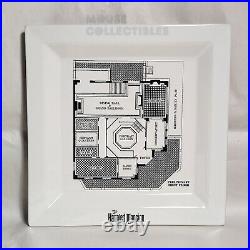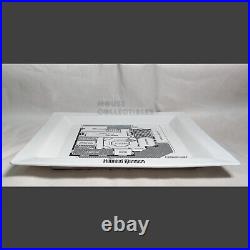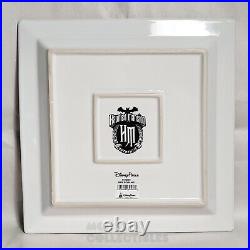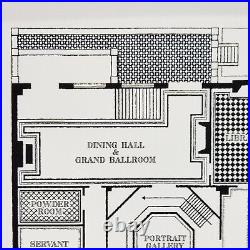









Disney Parks Haunted Mansion Blueprint Plate. Plate: “Preliminary First Floor” Dinner Plate. Size: 11 inches x 11 inches. Release Date: August 9, 2014. This hard to find plate features the “Preliminary First Floor” plans for Disneyland’s Haunted Mansion. The plans show the (Stretching) Portrait Gallery, gardens and family cemetery plot, the dining hall and grand ballroom and more! Fans of the Haunted Mansion will recognize many of the rooms from the attraction’s layout. The square white ceramic plate is sized for dinner/main course. It is approximately 11 inches x 11 inches (outer edges). It has a black blueprint design with the Haunted Mansion logo on the lip of the plate. This plate was released on August 9, 2014 as part of the merchandise for Disneyland’s Haunted Mansion 45th Anniversary celebration. The plate was later released at Memento Mori at Walt Disney World. This plate is retired and no longer available. Collector’s Note: This plate was originally released as part of the merchandise for Disneyland’s Haunted Mansion 45th Anniversary on August 9, 2014. All merchandise created for the anniversary has the “HM” Haunted Mansion crest that is on the back of the plate. Please send a message with any questions. The Haunted Mansion is a ghost train attraction located at Disneyland Park (Disneyland Resort), Magic Kingdom (Walt Disney World Resort), Tokyo Disneyland, Disneyland Park (Paris) and at Hong Kong Disneyland, although each location differs in design. Riders go through a haunted mansion resided in by 999 happy haunts. The Haunted Mansion features a ride-through tour in Omnimover vehicles called “Doom Buggies”, and a walk-through show is displayed to riders waiting in the line queue. The attraction utilizes a range of technology, from centuries-old theatrical effects to modern special effects featuring spectral Audio-Animatronics. The Haunted Mansion has inspired two similarly themed attractions, Phantom Manor and Mystic Manor, which exist at Disneyland Paris and Hong Kong Disneyland, respectively. The idea for the Mansion precedes Disneyland and WED Enterprises, dating to when Walt Disney hired the first of his Imagineers. At the time, the park they were developing the attraction for was supposed to be located across from the studios. In 1951, the first known illustration of the park showed a main street setting, green fields, western village and a carnival. Disney Legend Harper Goff developed a black-and-white sketch of a crooked street leading away from main street by a peaceful church and graveyard, with a run-down manor perched high on a hill that towered over Main Street. Disney assigned Imagineer Ken Anderson to create a story using Goff’s idea. Plans were made to build a New Orleans-themed land in the small transition area between Frontierland and Adventureland. Weeks later, New Orleans Square appeared on the souvenir map and promised a thieves market, a pirate wax museum, and a haunted house walk-through. Anderson studied New Orleans and old plantations and came up with a drawing of an antebellum manor overgrown with weeds, dead trees, swarms of bats and boarded doors and windows topped by a screeching cat as a weather vane. Disney, however, rejected the idea of having a run-down building in his park. He visited the Winchester Mystery House in San Jose, California, and was captivated by the massive mansion with its stairs to nowhere, doors that opened to walls and holes, and elevators. Anderson envisioned stories for the mansion, including tales of a ghostly sea captain who killed his nosy bride and then hanged himself, a mansion home to an unfortunate family, and a ghostly wedding party with well-known Disney villains and spooks. Imagineers Rolly Crump and Yale Gracey recreated Ken Anderson’s stories in a studio at WED Enterprises. In 1961, handbills announcing a 1963 opening of the Haunted Mansion were given out at Disneyland’s main entrance. Construction began a year later, and the exterior was completed in 1963. The attraction was previewed in a 1965 episode of Walt Disney’s Wonderful World of Color, but the attraction itself did not open until 1969. After the fair, many Imagineers such as Marc Davis, X Atencio and Claude Coats contributed ideas to the project. By this time, Ken Anderson had left the project. Rolly Crump showed Walt some designs for his version, which included bizarre objects like coffin clocks, candle men, talking chairs, man-eating plants, tiki-like busts, living gypsy wagons and a mirror with a face. Walt accepted these ideas and wanted to make the proclaimed “Museum of the Weird”, a restaurant side to the now-named Haunted Mansion, similar to the Blue Bayou at Pirates of the Caribbean. Though this concept was never realized, some of its aspects were implemented into the final attraction. When Walt put Imagineers Rolly Crump and Yale Gracey in charge of creating the visual illusions for the attraction, they intended to make the “Museum of the Weird” into a separate section that guests could walk through and discover illusions from around the world. Guests would be able to see transparent ghosts and other apparitions, utilizing the Pepper’s Ghost technique used in the theater since the early 1800s. Crump and Gracey were eventually given an entire warehouse to house their developments and one evening forgot to switch off the mechanics before leaving for the day. The cleaning crew was met with surprise as Crump explained, Once, we got a call from personnel saying that the janitors requested that we leave the lights on in there due to the creepiness of all the audio-animatronic ghosts and such. We complied, but put motion sensors in the room that would extinguish the lights and turn on all the ghost effects when triggered. The next morning, we came in and found all the ghost effects still running and a broom lying in the center of the floor. Personnel called and said that the janitors would not be back. Marc Davis and Claude Coats, two of the mansion’s main designers, disagreed on whether the ride should be frightening or enjoyable. Claude, originally a background artist, wanted a scary adventure, and produced renditions of moody surroundings like endless hallways, corridors of doors and numerous characterless environments. Marc, an animator and character designer, proposed variegated characters and thought the ride should be silly and full of gags. In the end, both artists got their ways when X Atencio combined their approaches and ideas, creating a transition from dark foreboding to “spirited” entertainment. The ride narration was performed by Paul Frees in the role of the Ghost Host. The attraction’s theme song, “Grim Grinning Ghosts”, was composed by Buddy Baker with lyrics written by X Atencio. It can be heard in nearly every area of the ride, with various instrumentations and tempos. After Disney’s death in December 1966, the project evolved significantly; the Museum of the Weird restaurant idea was abandoned. The Imagineers objected to a walk-through attraction’s low capacity, going so far as suggesting building two identical attractions to accommodate twice as many guests. A solution appeared with the development of the Omnimover system for Adventure Thru Inner Space. Renamed the'”Doom Buggy”, the system’s continuous chain of semi-enclosed vehicles offered high capacity. The cars could be set to rotate in any direction at any point, allowing the Imagineers to control what guests saw and heard throughout the show. And because each car held from one to three people, it was a convenient way to divide guests into smaller groups – a better fit with the story of people wandering “alone” through a haunted house. Employee previews of the Mansion were held August 6, 7, and the 8th, followed by “soft” openings on August 9 and 10 where limited numbers of park guests were allowed to ride. A “Midnight” Press Event was held on the evening of August 11. The mansion opened to all guests August 12, 1969. The public opening was announced in full-page newspaper ads, creating the anomaly of either two official openings or an advertised “soft” opening. The attraction was an immediate success, attracting record crowds and helping Disney recover from Walt’s untimely death. In around 1977, WDI considered utilizing the unused designs, creatures and effects that Rolly Crump had originally created for the Haunted Mansion and the Museum of the Weird as part of Professor Marvel’s Gallery – a tent show of mysteries and delights, a carousel of magic and wonder. This was to be built as part of Disneyland’s Discovery Bay expansion area, and was dropped when those plans fell through. The attraction opened at Magic Kingdom in 1971 and Tokyo Disneyland in 1983. In 1999, a retrospective of the art of The Haunted Mansion was featured at The Disney Gallery above the entrance to Pirates of the Caribbean. When the 2003 film The Haunted Mansion was released, a retrospective of its art was featured in the gallery as well. In 1994, Disneyland’s Haunted Mansion was updated. A phantom piano player sat at a run-down piano in the attic scene, just like the music room at Walt Disney World’s Mansion. However, instead of the sinister Rachmaninoff-esque version of “Grim Grinning Ghosts”, a dark version of Richard Wagner’s Bridal March plays. In 2001, a newer, more detailed safety spiel was added to the onboard audio of the doom buggy in the Load Area, now featuring voice-over artist and Paul Frees impersonator Joe Leahy, giving a bilingual safety spiel as part of a park-wide attempt to increase safety at attractions. The seasonal overlay Haunted Mansion Holiday premiered that October in Disneyland, featuring characters from the 1993 film The Nightmare Before Christmas. In 2004, the seance room was updated to allow the crystal ball to appear to float, while the projection of Madame Leota still appeared within the ball. Originally this was accomplished with projection mapping, and later from a rear projection effect within the ball. In 2006, the bride with the visible beating heart in the attic was replaced by another bride named Constance Hatchaway. Constance Hatchaway is the ride’s villainess who married many wealthy men in life, killing all of them for their wealth. The character was added to Walt Disney World’s Haunted Mansion in 2007. In 2007, the Haunted Mansion at Walt Disney World was reopened to the public. Included in the update was a more elaborate transformation of the foyer’s portrait, new sound, visual and audio effects in the Stretching Room, and a new Endless Staircase scene, which replaced the two rubber spiders seen just before the Endless Hallway scene. On April 10, 2015, it was officially confirmed that an iconic Haunted Mansion character, The Hatbox Ghost, would return to Disneyland’s Haunted Mansion. The Hatbox Ghost was originally a part of the attraction when it opened in 1969, but was removed when the illusion involving the specter’s head was not convincing enough. On January 21, 2020, Disneyland’s Haunted Mansion was closed for an extensive refurbishment to add lighted steel panels, improved lighting, mechanical touch ups, and new paint and trims to the exterior of the attraction. This refurbishment came with a refreshed pet cemetery, now with new greenery and plants. The portrait gallery was given new drapes curtains and the loading area is much more decorative with wallpaper and the return of one of the Haunted Mansion’s original portraits being “April to December”. Also featuring a statue of the one-eyed cat. The rest of the attraction was given repairs and new lighting. Due to the success of attractions that feature holiday overlays such as The Country Bear Christmas Special and It’s a Small World Holiday, the Haunted Mansion at Disneyland and Tokyo Disneyland is transformed into Haunted Mansion Holiday during the Halloween and Christmas seasons and has been since 2001, inspired by Tim Burton’s 1993 film The Nightmare Before Christmas. The Haunted Mansion is closed in mid to late August for a few weeks as they revamp the attraction before opening again in September, replacing many of the props and Audio-Animatronics with characters and themes from the movie. The Haunted Mansion Holiday closes in early January to restore the attraction back to the original Haunted Mansion and reopens late January. The Magic Kingdom does not have its own holiday edition of the Haunted Mansion and the regular ride operates continuously through the holiday season. The Magic Kingdom was initially supposed to have the overlay as sets, props, and animatronics were created for Magic Kingdom, but they rejected the overlay because Walt Disney World gains more tourists than Disneyland due to being a vacation destination unlike Disneyland being more of a regional theme park with reoccurring guests. So keeping the original ride year-round felt more appropriate. The sets, and props were sent to Tokyo Disneyland as their Haunted Mansion is a duplicate of Magic Kingdom’s version. Walt Disney Pictures produced a theatrical feature film adaptation based on the attraction and starring Eddie Murphy on November 26, 2003. In July 2010, Guillermo del Toro announced that he was set to write and produce a darker film adaptation based on the attraction, promising that it would be both scary and fun. By August 2020, it was announced that Katie Dippold would be writing a new script with Dan Lin and Jonathan Eirich servicing as producers. In April 2021, Justin Simien signed onto the project as director. In October 2005, Slave Labor Graphics began publishing a bimonthly Haunted Mansion comic book anthology, with the main recurring story (Mystery of the Manse) centered around “Master Gracey” and inspired by the sea captain concepts proposed for the attraction by Ken Anderson in the 1950s. In the Mickey Mouse episode “Potatoland”, Mickey and Donald build a theme park called Potatoland to fulfil Goofy’s lifelong dream to go to the park, even though it never existed. One of the attractions featured was a version of The Haunted Mansion, based on potato horror stories. In January 2014, Marvel Comics began publishing Seekers of the Weird, a five-issue miniseries and first under the Disney Kingdoms imprint. The miniseries was based on the Museum of the Weird, Rolly Crump’s unused precursor designs for the attraction. In March 2016, Marvel Comics began publishing a five-issue miniseries based on the attraction, released under the Disney Kingdoms imprint. A video game produced by Disney Interactive, TDK, and High Voltage Software was released in 2003, primarily based on the attraction but using some of the set designs from the film. The attraction appears and is referenced in other video games, including Epic Mickey and Kinect: Disneyland Adventures. In Epic Mickey, the mansion serves as a level in the game, and borrows elements from each mansion except for Mystic Manor. In July 2014, it was announced that a cartoon special based on the attraction, animated by Gris Grimly, was being developed in honor of the 45th anniversary, to be aired on the Disney Channel and Disney XD. Madame Leota appears in the second half of the seventh season of ABC’s Once Upon a Time, portrayed by Suzy Joachim. In the horror video game Bendy and the Ink Machine, the haunted house attraction that appears in the game’s fourth chapter is based on the ride. In October 2018, it was reported that the Magic Kingdom was turning into a popular place for families to deposit ashes of their deceased loved ones, with the Haunted Mansion picked as their favorite location. The behavior of depositing ashes of dead family members at the attraction is considered unacceptable and unlawful, and anyone caught doing that behavior will be escorted from the park. In 2020, Funko Games partnered with Disney to release the family strategy board game Disney: The Haunted Mansion– Call of the Spirits. In May 2021, it was announced that a Muppets special based on the attraction, Muppets Haunted Mansion, would be released on Disney+ in the fall of 2021.

